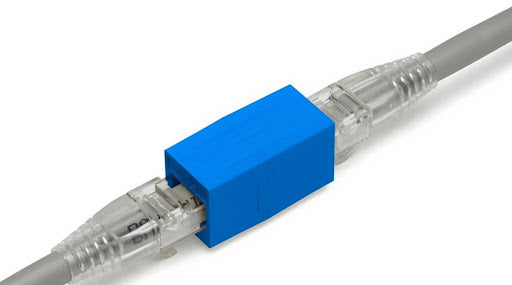Payment methods accepted

All About Ethernet Couplers: What They Are, How They Work, and How to Use Them
Written by Don Schultz, trueCABLE Senior Technical Advisor, Fluke Networks Copper/Fiber CCTT, BICSI INST1, INSTC, INSTF Certified
Ethernet couplers have been a source of frustration for many installers over the years for various reasons. Many professional installers eschew their use altogether, and other installers (professional and DIY alike) have used them without issue. Why the huge disparity in opinions and experiences? Well, it comes down to the fact that an “Ethernet cable coupler” as a stand-alone component has no formal component specification in the ANSI/TIA 568 standards. There is no data or guidance dictating their construction, performance, or use to be found. Yet, these accessories exist and can be purchased, although quality control is a major variable. Technically speaking, there is no formal data to point back to and reference to give us a baseline of how inline couplers or keystone couplers should behave.
So, let’s talk about these accessories and take a deep dive to help sort out rumors from facts with some empirical evidence!
Here is a high level overview of RJ45 female to female couplers that should be helpful, but after watching the video I suggest you come right back and keep reading as there is a second video further down talking about issues and best practices with actual Fluke DSX-8000 testing!
What is an Ethernet coupler?
Ethernet couplers have a single purpose in life, which is to join two segments of an Ethernet channel together. An Ethernet channel is defined as the continuous and all-inclusive communications path between two powered devices (Ethernet switch to switch, or Ethernet switch to computer or other device). Sometimes the channel is not physically long enough to get from point A to point B, and this is where couplers can come in handy. A common scenario is you have two patch cords, and each one is too short on its own but if you combine the two you have a long enough cord. Another common scenario is a mistake, where your carefully planned solid copper Ethernet cable drop is too short, but you have no time or extra cable to immediately remove and re-run the cable drop and need a temporary solution ASAP.

Sorry folks, this won't cut it with Ethernet cable! (image courtesy of iStock)
At trueCABLE we are often asked how to connect two Ethernet cables without a coupler. The answer is, you cannot. You see, modern Ethernet cables such as Cat5e, Cat6, Cat6A, or Cat8 cannot be physically spliced together and still provide reliable gigabit (or above) transmission speeds. There must be an accessory used, as copper twisted pair Ethernet cable is carefully balanced and designed to such tight tolerances that it won’t behave like electrical cable that often can be spliced together in the traditional way (solder, joining two wires together directly, etc.).
Couplers come in two primary varieties:
- IDC coupler (also called a splice box or junction box)
- RJ45 female to female coupler
Both primary types are (or should be) Category rated to match the Ethernet cable you are joining. There is a PCB (printed circuit board) inside of any coupler, just like you find inside traditional Ethernet keystone jacks.

Cat6 Unshielded IDC coupler (aka “splice box” or “junction box”) (image courtesy of SFCable)
IDC couplers are quite similar to keystone jacks in that you must wire them on both sides just like you are terminating a keystone jack where all eight wires are hooked up on both sides. This means you are joining two raw cables that have not been terminated to anything (yet). IDC couplers are terminated on both sides by punching down the individual insulated conductors wires into the T568A or T568B pattern into contact terminal slots. IDC couplers are effective devices for transitioning from indoor to outdoor cable with minimal disruption to performance of your overall channel, assuming they are designed well. The downside is IDC couplers normally cannot cope with higher bandwidths such as 5GBASE-T and especially 10GBASE-T which is why you won’t normally find Cat6A IDC splice box couplers. As it turns out, ANEXT or Alien Crosstalk becomes a big problem at the coupler. 99.9% of all IDC couplers fall into the Cat5e coupler and Cat6 coupler realm, but they do come in shielded and unshielded varieties. You no longer see a Cat5 coupler for sale as the Cat5 Category has been obsolete for many years, no longer being ANSI/TIA recognized.

RJ45 couplers are the second and most common variety. These devices are designed to join two Ethernet patch cables together that have already been terminated on both ends with 8P8C (aka RJ45) modular plugs. There are two subtypes of this kind of coupler:

RJ45 Keystone Coupler
Inline and keystone couplers are absolutely identical in their intended function--join two pre-terminated patch cords together. The only difference is keystone couplers are designed to snap into a wall plate where inline couplers won’t mount to anything. Why would one use keystone couplers? Keystone couplers, when combined with high quality Ethernet patch cords, can be used to create an easy to setup ad-hoc LAN that is mobile in nature. Temporary hospital units, music festivals, and LAN gaming parties with revolving venues are all candidates for this kind of coupler.
Both varieties of RJ45 female to female couplers also come in waterproof Ethernet coupler designs for outdoor use. All varieties of inline couplers are (or should be) Category rated and come in shielded and unshielded depending on what Category of Ethernet cable you are using and if it is shielded or unshielded.
One significant advantage of inline and keystone RJ45 female to female couplers is their ability to prevent ANEXT (Alien Crosstalk) at the connection point. Carefully tuned printed circuit boards and/or shielding gives this type of coupler the edge over IDC splice junction box type couplers.
Performance Considerations
This is where we get into the fun part. Couplers can become the source of data transmission issues if not used correctly and judiciously.
Here is the second video, as promised, demonstrating how you can get yourself into trouble with Ethernet couplers. After watching the video, please come back again for some best practices and closing thoughts!
Generalized Guidelines for Coupler Use
Now that you have seen that couplers can cause you issues, here are some generalized guidelines to keep you out of trouble:
It should be noted that these rules assume you have terminated your solid copper cable to Field Termination Plugs at the coupler or you are using good quality patch cables (factory assembled and component rated).
Tips for Success:
- It never hurts to use the highest Category rated coupler you can find as they are backwards compatible
- You can use unshielded cable with shielded couplers, just don’t use shielded cable with unshielded couplers
- Keep your coupler use minimal, avoiding the use of more than one per channel if you can. With that said:
- NEVER exceed three couplers in a Cat5e or Cat6 2.5Gb/s or 5Gb/s cable channel segment (powered device to powered device) if you want your segment to work at all
- NEVER exceed two couplers in a Cat6A 10Gb/s cable channel segment if you want to reach 10G at all
- If the quality of your coupler or any component is unknown, restrict your use to a single coupler and no more, regardless of speed
- Note that if you are a professional installer and work to a contract, you may be prohibited from using couplers at all
So, there you have it! Ethernet couplers finally explained and with actual data. These handy accessories have saved many IT people and DIY folks from having no network connection at all, so I think we will keep them around but educate everyone on how to use them so you don’t run into trouble.
HAPPY NETWORKING!
trueCABLE presents the information on our website, including the “Cable Academy” blog and live chat support, as a service to our customers and other visitors to our website subject to our website terms and conditions. While the information on this website is about data networking and electrical issues, it is not professional advice and any reliance on such material is at your own risk.



























